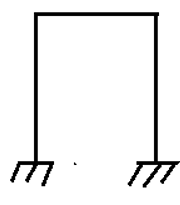This set of Structural Analysis Multiple Choice Questions & Answers (MCQs) focuses on “Kinematic Indeterminacy of Trusses”.
1. The degree of freedom for the vertical guided roller is ________
a) 0
b) 1
c) 2
d) 3
View Answer
Explanation: Vertical guided roller resists horizontal/axial force and bending moment. However, it cannot resist vertical forces as it slides down along the plane. Hence it has 1 degree of freedom.

2. What is kinematic indeterminacy for the given figure considering axial deformation?

a) 0
b) 2
c) 4
d) 6
View Answer
Explanation: The given beam is supported by roller support at both of its ends. Roller support, if considering axial deformation has two degrees of freedom i.e. Rotation and Horizontal sway. Therefore, the degree of freedom of the beam is 4.
3. What is kinematic indeterminacy for the given figure without considering axial deformation?

a) 0
b) 2
c) 4
d) 6
View Answer
Explanation: The given beam is supported by roller support at both of its ends. Roller support, if not considering axial deformation has one degree of freedom i.e. Rotation. Therefore, the degree of freedom of the beam is 2.
4. What is kinematic indeterminacy for the given figure considering axial deformation?

a) 0
b) 4
c) 6
d) 10
View Answer
Explanation: The given beam is supported by fixed support at both of it ends. Fixed support, if not considering axial deformation does not any degree of freedom. Therefore, the degree of freedom of the beam is 0.
5. What is kinematic indeterminacy for the given figure?

a) 0
b) 1
c) 2
d) 3
View Answer
Explanation: The given beam is supported by fixed supports at both of its ends and intermediary roller support. Fixed does not provide any degree of freedom. Whereas, roller support provides both rotation and horizontal sway. But horizontal sway is already restricted by the ends fixed support. Thus, the only degree of freedom is the rotation about roller support.
6. The degree of freedom of a joint for the rigid jointed joint plane frame is _____
a) 0
b) 2
c) 3
d) 6
View Answer
Explanation: Number of degree of freedom of a joint for the rigid jointed plane frame is 3 i.e. Horizontal sway, Vertical sway, and Rotation.
7. What is kinematic indeterminacy for the given figure without considering axial deformation?

a) 0
b) 2
c) 4
d) 6
View Answer
Explanation: The given set of frame consists of fixed end supports with two intermediate rigid joints. Each rigid joint allows horizontal sway, vertical sway, and rotation. Therefore, two rigid joints will have six degrees of freedom.
8. What is kinematic indeterminacy for the given figure without considering axial deformation?

a) 0
b) 2
c) 3
d) 6
View Answer
Explanation: The given set of frame consists of fixed end supports with two intermediate rigid joints. Each rigid joint allows horizontal sway, vertical sway, and rotation. But since the axial deformation is to be neglected. Therefore, vertical sway of the joints and either horizontal sway of a joint is neglected. Hence, degree of freedom is three.
9. The degree of freedom for a rigid jointed plane frame without axial deformation is given by 3j – m – r.
a) True
b) False
View Answer
Explanation: The degree of freedom for a rigid jointed plane frame without axial deformation is given by 3j – r, where j is the number of joint and r is the number of reactions.
10. The degree of freedom of the given typical joint is ______

a) 1
b) 2
c) 3
d) 4
View Answer
Explanation: Horizontal hinged joint provides four degrees of freedom. Four freedom at the horizontal hinged joint are horizontal sways of both connected members, vertical deflection of the joint and rotation of the joint.
Sanfoundry Global Education & Learning Series – Structural Analysis.
To practice all areas of Structural Analysis, here is complete set of 1000+ Multiple Choice Questions and Answers.
If you find a mistake in question / option / answer, kindly take a screenshot and email to [email protected]
- Apply for Civil Engineering Internship
- Check Structural Analysis Books
- Practice Civil Engineering MCQs
- Check Civil Engineering Books
